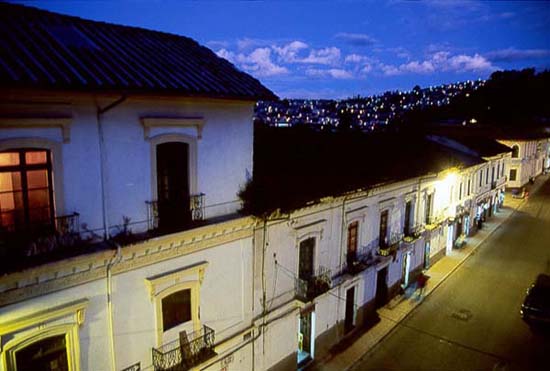
Andean Condors by PCVs Sarah Gale Koenen and Marcus Koenen,
Andean Condors
Since the early 1970's, the Andean Condor has been listed as endangered by the US Fish and Wildlife Service. Although no one has completed an accurate census of the birds, their numbers are believed to be declining in Ecuador. Current estimates indicate between 50 and 100 individuals.
Locally a pair is believed to nest near Lake Cuicocha in the Cotacachi Cayapas Ecological Reserve. Condor sightings are reported in the Zuleta valley and birds are seen around the Mojanda Lakes. Visitors to Casa Mojanda occasionally report condors flying over the property and around the riding trails.
Condors have never been as common in Ecuador as they are in the southern Andes, especially Chile and Peru where open land is more typical. They prefer open areas that enhance their ability to find carcasses, their main food source. In the northern Andes there is more forest cover, so condors are mainly found in the high grasslands (paramos) and rocky cliffs. In Peru, condors can be found nesting in coastal cliffs where they benefit from broad non-forested areas.
Photo-census surveys that were once employed to determine the numbers of California Condors are being used to study the local Andean population. Although far from complete, the work indicates a shortage of juvenile condors; most of the sightings are of adults.
The reasons juveniles are not seen as often as expected is not understood. It may be a result of irregular breeding due to chemicals in the environment or food shortages that reduce a parentís ability to provide for their young. Because of their natural curiousity, juveniles may become easier prey for hunters. Also, studies may have been inadvertantly limited to areas that are not inhabited by juveniles. Much additional information is needed before we can successfully implement a comprehensive conservation program.
What is a Condor? The Andean Condor belong to a family of birds that include Turkey Vultures, Black Vultures, California Condors and the rare King Vulture. These American Vultures share many interesting characteristics; such as being specialized carrion eaters, having a bald head, and weak flight muscles. Instead of flapping their wings to fly, vultures often soar by relying on rising air currents to carry them from one place of another.
What does a Condor look like? Juvenile condors are all gray. Once they reach maturity at 8 years of age, the adult condors are easily identified by the white on the backs of their wings, black bodies, and white neck collars. The males and females are very difficult to tell apart in flight. While males are slightly larger than a female, it is the presence of a crest on top of the head that truly identifies a male. Individual condors can also be identified by carefully looking for gaps or missing feathers in their wings.
Where do Condors Live? At one time the Andean Condors lived from Venezuela in the North to Tierra del Fuego in the South. While still found in most of their former range, the numbers of birds are greatly diminished today. They are still found in the high altitude areas (above 3,000 m) in Ecuador. Most are seen soaring above the high altitude grasslands where they search for food.
Where do Condors Nest? Condor nests are found in caves among the steep cliffs in the paramos. These secluded areas offer excellent protection from predators. The Andean Condors must nest in safe areas because the females lay only 1 egg every 2 years. They can lay more eggs but wait because a young condor must be cared for up to 1 year before it becomes independent.
What do Condors Eat? Like their relatives, the Andean condors eat carrion. They feed on any wild or domestic animal carcasses found in their habitat. Even so, there are many stories about condors preying on farm animals, pushing calves off cliffs or killing large cattle. As a result condors are sometimes persecuted, shot or poisoned. While condors can kill prey given the right circumstances, many such stories are patently untrue. A Condor's feet are not capable of grabbing and flying off with prey.
What are we doing to protect the condor? The Ecuadorian ornithological organization, CECIA, is collaborating with Peace Corps, the US Department of the Interior, USAID, and INEFAN to conserve condors in their native habitat. A current study focuses on identifying critical habitat and defining management needs. In addition, the conservation project is working with communities around the reserves by offering environmental education and developing alternative income sources that protect the condor's habitat.
What can you do to help? There are a number of ways you can help condor preservation:
1) Share what you know about condors with your friends and family.
2) Report any condors you see to CECIA at the address below. Your information will help us locate and observe condors.
3) Please consider a financial donation to CECIA that will further our conservation efforts. Please send contributions or inquiries to:
CECIA, PO Box 17-17-906, Quito, Ecuador
Tele: 02-433-238 or cecia@uio.satnet.net
The above information provided by
Sarah Gale Koenen and Marcus Koenen,
Peace Corps Volunteers, 1998
Published and distributed by The Mojanda Foundation
Casilla 160, Otavalo, Ecuador
mojanda@uio.telconet.net http://www.casamojanda.com/foundation
